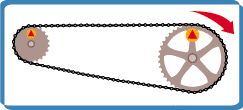Bicycle Gearing
The purpose of a bike transmission is to transfer
the power of the foot to the power that propels the bike
forward. The force of the foot provides a torque which
provides a tension on the chain which provides a torque
for the back wheel. That torque provides a frictional
force that propels the bike. The difference in radii
between the foot and the front gear provides a mechanical
advantage. The power is the same across the entire system
but the amount of force and velocity adjusts resulting in
the same amount of power.

For example, if a bicycle rider
wants to get up a large incline but doesn’t want to
destroy their legs, they can shift into a gear that lets
them rotate the crank many times to turn the back wheel
just once. This will result in more torque at the back
wheel and the amount of force that the rider outputs is
smaller at the expense of having to spin the pedals
faster. The opposite is true if you are on flats and you
want to travel faster. By choosing a larger drive gear and
a smaller driven gear, the back wheel will have less
torque but will complete more revolutions.

http://www.exploratorium.edu/cycling/gears1.html
Transmission systems
of bikes are often discussed in gear ratios. If I had a
front gear with 30 teeth and a back gear with 15 teeth it
would have a gear ratio of 2:1. This means that for every
revolution that I make on the front gear with my foot the
back gear will rotate two times. Modern road bikes
commonly have up to 22 gear combinations due to two front
chainrings and 11 rear cogs allowing riders to select the
most efficient gear ratio for their situation.